About 91 km toward the northeast of Yangon, the lovely town of Bago has been listed on the top Myanmar tourist attractions. The early history of Bago is also more or less legendary. Tradition recounts that in the far distant past a hamsa bird (Brahmani duck) alighted on a small patch of ground in the shallow sea. The unsubmerged spot was so tiny that the mate of the hamsa found no room to rest upon and had to perch on the back of the male bird. In course of time, the delta expanded and the little spot became a significant hillock. It later acquired some sort of historical importance and came to be known as Hinthagone, the resting place of two hamsa birds. Assuming a historical landmark this natural mound is now consecrated by having a pagoda built on it.
The Mons were first settled at this site and apparently some Indian immigrants formed an important section of the inhabitants. The place was named Ussa probably derived from the Indian province Orissa. But, the first city was founded by two Mon brothers, Thamala and Wimala from Thaton about 825 A.C. After 260 years the city came under Myanmar domination and remained eclipsed for more than three hundred years. It was only in 1369 that Byinnya-U, a descendant of Wareru (1287-96) king of Martaban, removed the capital to Bago. Since then the city, as well as the delta region of the Mons, was popularly known as Hamsavati (Hanthawaddy). The ruins of the fort walls lie to the east the Shwemawdaw pagoda. Rajadarit (1385-1423), Queen Shinsawbu (1453-72) and Dhammaceti (1472-92) were famous rulers of the dynasty.
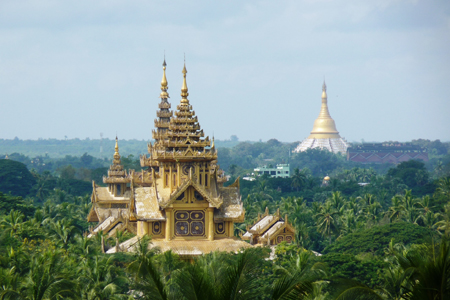
In 1541, Tabinshwehti of the Myanmar dynasty at Toungoo annexed Bago state. Bayinnaung, his successor, built the new city of Hanthawaddy in 1566. But during Thalun’s reign, the capital was moved to Inwa in 1635. The Mons, after rising against Inwa in 1740, had a brief spell of independence. Finally, when Alaungpaya established himself king in Upper Myanmar he regained Bago and it remained subject to Inwa till the British annexation in 1852.
As in other ancient sites few structures of secular use, apart from the remains of the old moated walls, are to be seen. Among the religious monuments, the Shwemawdaw is one of the most venerated pagodas in Myanmar. Tradition ascribes the original construction of the pagoda to two merchant brothers who enshrined two sacred hairs bestowed upon them by Buddha during his lifetime. Kings Thamala and Wimala raised the height to 81 and 88 feet respectively in 825 and 840. Successive Kings contributed towards its renovation and enlargement, and when Bodawpava replaced a new hti (umbrella) in 1796 it attained to a height of 297 feet. The architectural interest of the pagoda lies in its having an octagonal base and elaborate multiplane projections in the lower portion. Around its base is a double range of small shrines. The pagoda was shattered by three major earthquakes in 1912, 1917 and 1930. The last tremor was so severe that a great part of the bell-shaped dome and its superstructure tumbled down, thus causing damage to the terraces also. After the last war, earnest efforts were made by the state and the public to restore the pagoda to its old glory and the reconstruction, on a model slightly different from the past, was completed in 1954. The height of the pagoda is now 375 feet. Several ancient Buddha images of stone and bronze, which were recovered from the ruined sectors of the pagoda, are now exhibited in the pagoda museum on the platform.
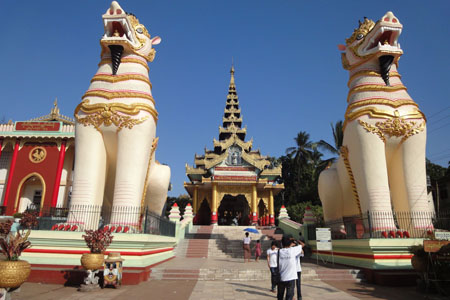
Bago is also noted for the largest reclining image of Buddha, 180 feet in length and 52 feet’ in height. It is the Shwethalyaung Image built by King Migadippa the younger in 994. Lying shelterless for several centuries the masonry image gradually became dilapidated and remained in a state of disrepair until Dhammaceti renovated it in the 15th century. Bayinnaung also maintained it in a proper manner but later on, it was neglected again and was overgrown with the shrub. The image was re-discovered about 80 years ago when its sanctity and glory was restored through intensive repairs. An iron tazaung (open shed) was constructed over it in 1906, and since then the image has regained the country-wide veneration of the Buddhist populace.
King Dhammaceti, also known as Ramadhipati, one of the most enlightened and wise rulers of Hanthawaddy, was a fervent promoter of Buddhism. He sent a mission of monks to Ceylon in 1475 where they received re-ordination in the presence of the members of the Mahavihara sect which was founded by the great apostle.
Mahinda in the 3rd century B.C. The purpose of the mission was to establish on an indisputable basis a canonically valid monastic succession of the Mon monks. On their return to Hanthawaddy, the monks brought the sand from the Kalyani river in Ceylon and had a suitable site consecrated after spreading the sand over it. On that site, Dhammaceti erected the Kalyani Sima (ordination hall), the first of its kind in Myanmar. The original structure was repaired by Bayinnaung and later in 1612 a new building was constructed by Anaukpetlun to replace it. In 1765 it had to be rebuilt by Bodawpaya. Twice again it was overtaken by calamities and new structures were built over the ruins. The last building in 1902 was badly damaged by the earthquake of 1930. It was therefore dismantled in 1954 and the present new Sima was constructed by public donations.
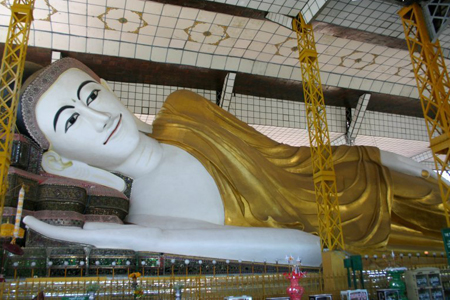
On the west of the Sima are ten huge stone pillars covered with inscriptions on both sides, except the 9th and 10th stones which are incised on one face only. These were set up in 1476 by Dhammaceti in order to record the ceremonial relating to the consecration of the Kalyani Sima. The great value of the inscription rests on the detailed information it gives of the early history of Buddhism in Myanmar, of the valid mode of consecrating ordination halls, of the intercourse of Bago and Myanmar with Ceylon and South India in the 15th century and of the Myanmar view of the apostolic successions of the Buddhist priesthood. The language of the first three stones is Pali and that of the rest is Mon. Most of these are more or less broken into fragments but copies of the Pali text on palm-leaf are still extant.
Obtaining a duplicate tooth-relic of Buddha from Ceylon, Bayinnaung (also known as Hanthawaddy Hsinbyushin) constructed the Mahazedi pagoda on the model of the Mahacetiya of Ceylon and enshrined the sacred relic in 1560. The square basement of this pagoda originally measured 320 feet on each side. Being subjected to several earthquakes it remained in disrepair for many centuries. The work of reconstructing the great pagoda was begun recently and is still in progress.
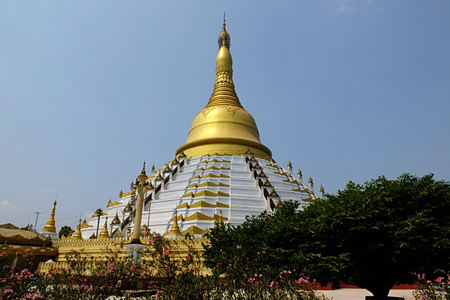
At the Payathonzu village three miles south of Bago is a cluster of ruined monuments originally built by Dhammaceti. Of these, the Shwegugyi is the largest and most important. It was built in imitation of the Bodhgaya Temple in India. Nearby are monuments built in honor of Buddha’s seven stations where he spent seven weeks after his enlightenment. It is recorded that each station was fitly adorned with large statues of most of the personages who played important roles in it. Unfortunately, all these statues have disappeared and only the ruins of structures and inscribed stones still remain. In the niches of the enclosure wall were placed large clay plaques, some glazed in green and some in brown, bearing bas-reliefs representing the monstrous army of Mara. There are two figures in each brick and each set is distinguished from others by the heads of animals surmounting the human bodies of the warriors and by the weapons held in their hands. At the site of the Ajapala tree where Buddha spent His fifth week after enlightenment is the ruined shrine where among the debris were found glazed plaques depicting figures of women in various stages of life, beautifully dressed and adorned. They represent the one hundred women of diverse ages into whom each of Mara’s daughters transformed herself in tempting the Buddha who was meditating under the tree. Those that still remains were collected and are now preserved in the Archaeological Department.
In the same locality is another monument in the form of four gigantic seated Buddha images placed against the sides of a massive brick pillar. This was also built by Dhammaceti. Though shelterless it is kept in a fair state of preservation by devout Buddhists. It is called the Kyaikpun pagoda.
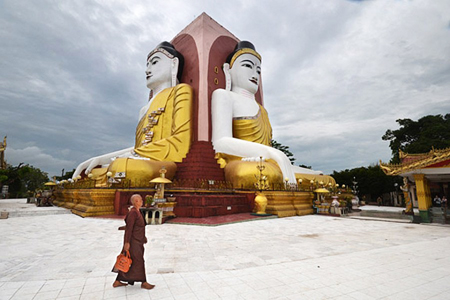
At the West, Shwenatha pagoda is a stone statue of standing Buddha with an Indian cast of features. He stands in very bold relief against an exquisitely ornamented back-slab, 6 feet high, which together with the Buddha were carved out of the same piece of solid stone. His right-hand holds something like a towel, while his left hand assumes the protection pose. At his waist is a girdle of cloth the long ends of which hang down between his legs. The image is believed to have been brought over from Ceylon during the reign of Dhammaceti. Iconographically the sculpture may be dated to the 10th-11th century.
Sculptures of earlier date were discovered at the Kyontu pagoda in Waw about 18 miles north-east of Bago. These are clay plaques roughly 1 foot 6 inches square, each bearing a round medallion carved in low relief, enclosed by a beaded border, floral designs, and corner semi-circles. The scenes in the medallions depict bullfights, riders on elephants and horses, and dancers and musicians. They all bear the stamp of Indian craftsmanship and some plaques have Indian numerals in Telegu-Kanarese script on the upper rims.
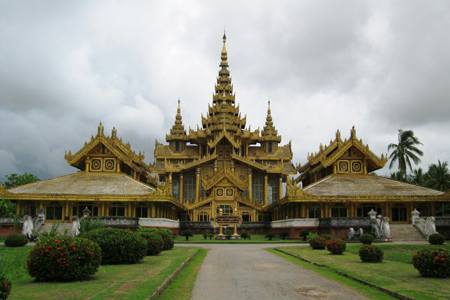
A stone slab bearing a Pali inscription in South Indian characters of 7th- 8th century was discovered recently at Kunzeik village on the east bank of the Sittang river, about 40 miles northeast of Bago. The inscription of 16 lines on the obverse and 3 lines on the reverse is an excerpt from the Vinaya Mahavagga similar to the inscription on the first few pages of the gold-leaf Pali manuscript recovered from Khinba mound at Sri Ksetra. The traces of Indian culture represented by the sculptures and this Pali inscription definitely attest to the close and continuous contacts between this part of the country and the peoples and cultures of India since the early centuries of the Christian era.
Explore the charming city of Bago with Go Myanmar Tours:
You might like:
Bago day trip – 1 Day
Yangon – Golden Rock – Hpa An – Bago tour – 4 Days
The best of Yangon – 5 Days
Please notice that all tours can be customized upon your schedule and interest, just feel free to contact us and let our travel expert help you to create your unique trip to Myanmar.
